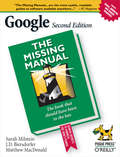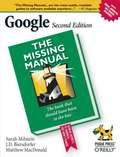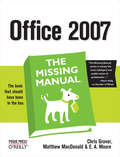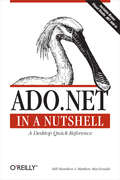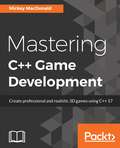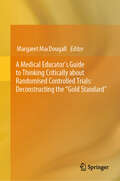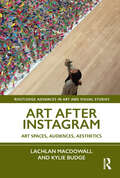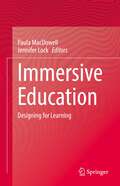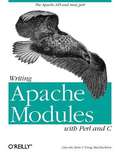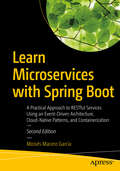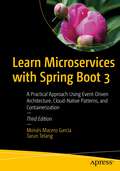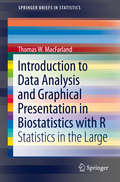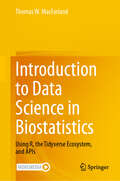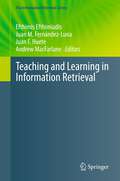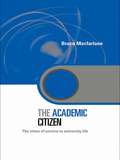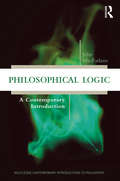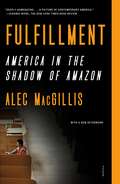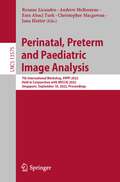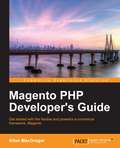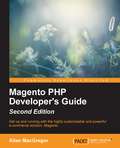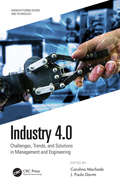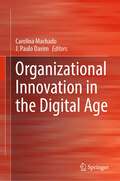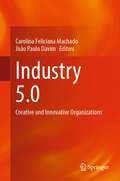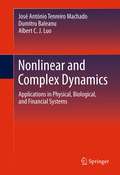- Table View
- List View
Google: The Missing Manual (Google: The Missing Manual)
by Matthew Macdonald Rael Dornfest J. D. Biersdorfer Sarah MilsteinGoogle.com is one of the most popular sites on the Internet and is used around the world by millions of people every day. Sure, you know how to "Google it" when you're searching for something--anything!--on the Web. It's plenty fast and easy to use. But did you know how much more you could achieve with the world's best search engine by clicking beyond the "Google Search" button?While you can interface with Google in 97 languages and glean results in 35, you can't find any kind of instruction manual from Google. Lucky for you, our fully updated and greatly expanded second edition to the bestselling Google: The Missing Manual covers everything you could possibly want to know about Google, including the newest and coolest--and often most underused (what is Froogle, anyway?)--features. There's even a full chapter devoted to Gmail, Google's free email service that includes a whopping 2.5 GB of space).This wise and witty guide delivers the complete scoop on Google, from how it works to how you can search far more effectively and efficiently (no more scrolling through 168 pages of seemingly irrelevant results); take best advantage of Google's lesser-known features, such as Google Print, Google Desktop, and Google Suggest; get your website listed on Google; track your visitors with Google Analytics; make money with AdWords and AdSense; and much more.Whether you're new to Google or already a many-times-a-day user, you're sure to find tutorials, tips, tricks, and tools that take you well beyond simple search to Google gurudom.
Google: The Missing Manual, 2nd Edition
by Matthew Macdonald Rael Dornfest J. D. Biersdorfer Sarah MilsteinGoogle.com is one of the most popular sites on the Internet and is used around the world by millions of people every day. Sure, you know how to "Google it" when you're searching for something--anything!--on the Web. It's plenty fast and easy to use. But did you know how much more you could achieve with the world's best search engine by clicking beyond the "Google Search" button? While you can interface with Google in 97 languages and glean results in 35, you can't find any kind of instruction manual from Google. Lucky for you, our fully updated and greatly expanded second edition to the bestselling Google: The Missing Manual covers everything you could possibly want to know about Google, including the newest and coolest--and often most underused (what is Froogle, anyway?)--features. There's even a full chapter devoted to Gmail, Google's free email service that includes a whopping 2.5 GB of space). This wise and witty guide delivers the complete scoop on Google, from how it works to how you can search far more effectively and efficiently (no more scrolling through 168 pages of seemingly irrelevant results); take best advantage of Google's lesser-known features, such as Google Print, Google Desktop, and Google Suggest; get your website listed on Google; track your visitors with Google Analytics; make money with AdWords and AdSense; and much more. Whether you're new to Google or already a many-times-a-day user, you're sure to find tutorials, tips, tricks, and tools that take you well beyond simple search to Google gurudom.
Office 2007: The Missing Manual (The\missing Manual Ser.)
by Matthew Macdonald Chris Grover E. A. Vander VeerQuickly learn the most useful features of Microsoft Office 2007 with our easy to read four-in-one guide. This fast-paced book gives you the basics of Word, Excel, PowerPoint and Access so you can start using the new versions of these major Office applications right away. Unlike every previous version, Office 2007 offers a completely redesigned user interface for each program. Microsoft has replaced the familiar menus with a new tabbed toolbar (or "ribbon"), and added other features such as "live preview" that lets you see exactly what each option will look like in the document before you choose it. This is good news for longtime users who never knew about some amazing Office features because they were hidden among cluttered and outdated menus. Adapting to the new format is going to be a shock -- especially if you're a longtime user. That's where Office 2007: The Missing Manual comes in. Rather than present a lot of arcane detail, this quick & friendly primer teaches you how to work with the most-used Office features, with four separate sections covering the four programs. The book offers a walkthrough of Microsoft's redesigned Office user interface before taking you through the basics of creating text documents, spreadsheets, presentations, and databases with:Clear explanations Step-by-step instructions Lots of illustrations Plenty of friendly advice It's a great way to master all 4 programs without having to stock up on a shelf-load of different books. This book has everything you need to get you up to speed fast. Office 2007: The Missing Manual is truly the book that should have been in the box.
ADO.NET in a Nutshell (In a Nutshell (O'Reilly))
by Matthew Macdonald Bill HamiltonWritten by experts on the Microsoft® .NET programming platform, ADO.NET in a Nutshell delivers everything .NET programmers will need to get a jump-start on ADO.NET technology or to sharpen their skills even further. In the tradition of O'Reilly's In a Nutshell Series, ADO.NET in a Nutshell is the most complete and concise source of ADO.NET information available. ADO.NET is the suite of data access technologies in the .NET Framework that developers use to build applications services accessing relational data and XML. Connecting to databases is a fundamental part of most applications, whether they are web, Windows®, distributed, client/server, XML Web Services, or something entirely different. But ADO.NET is substantially different from Microsoft's previous data access technologies--including the previous version of ADO--so even experienced developers need to understand the basics of the new disconnected model before they start programming with it. Current with the .NET Framework 1.1, ADO.NET in a Nutshell offers one place to look when you need help with anything related to this essential technology, including a reference to the ADO.NET namespaces and object model. In addition to being a valuable reference, this book provides a concise foundation for programming with ADO.NET and covers a variety of issues that programmers face when developing web applications or Web Services that rely on database access. Using C#, this book presents real world, practical examples that will help you put ADO.NET to work immediately. Topics covered in the book include: An Introduction to ADO.NET Connections, Commands and DataReaders Disconnected Data Advanced DataSets Transactions DataViews and Data Binding XML and the DataSet Included with the book is a Visual Studio .NET add-in that integrates the entire reference directly into your help files. When combining ADO.NET in a Nutshell with other books from O'Reilly's .NET In a Nutshell series, you'll have a comprehensive, detailed and independent reference collection that will help you become more productive.
Mastering C++ Game Development: Create professional and realistic 3D games using C++ 17
by Mickey MacdonaldHigh-end game development with advanced C++ 17 programming techniques Key Features Make the best use of object-oriented capabilities of C++ 17 to develop high-end games Create reusable C++ 17 libraries and editor tools for your game Series of example projects demonstrating advanced techniques to build games of any genre Book Description Although many languages are now being used to develop games, C++ remains the standard for professional development. The majority of professional libraries and toolchains are still built using C++. The primary goal of this book is to teach you how to harness the power of the language and provide you with the ability to build high-quality games. To begin, you will be presented with, an overview of popular development methodologies, and a short guide to updated features of the C++ 17 standard. You will learn how to leverage existing libraries such as OpenGL and the STL (standard library) to build complex systems. Throughout the journey, you will also build a set of C++ 17 compatible libraries that can be reused in your own development projects. In the last half of the book, you will work with demos designed to introduce you to advanced rendering techniques, interactive physics, advanced AI techniques, and even multiplayer game concerns with modern networks. What you will learn Work and communicate effectively in the modern games industry Develop simple and advanced gameplay systems How to leverage the standard core C++ libraries Use modern real-time rendering techniques to achieve immersive 3D visuals Achieve a narrative-driven game experience using a variety of data management techniques Implement scripting using LUA Learn AI algorithms and concepts for handling motion, behavior, and decision making Implementation of the OpenGL, Bullet Physics, GLM, SteamVR and other common libraries Who this book is for This book is intended for aspiring game developers who are proficient in C++ 17 programming and are interested in developing professional games with C++.17
A Medical Educator's Guide to Thinking Critically about Randomised Controlled Trials: Deconstructing the "Gold Standard"
by Margaret MacDougallDrawing on the statistical and philosophical expertise of its authors, this book is designed to improve understanding and use of randomised controlled trials (RCTs) among health professionals. It is intended for use primarily by medical educators involved in teaching statistics and evidence-based medicine (EBM) to medical students, junior doctors and other health professionals. However, each of the chapters serves a wider range of interests, including the practical needs of physicians in interpreting research evidence to support clinical decision making and the teaching needs of philosophers of medicine who want to more fully appreciate how RCTs work in practice and provide engaging examples for their students. Rather than compete with the proliferating methodological literature on RCT designs, this book focuses on cultivating a healthy skepticism among developing health professionals to support critical appraisal of their own and published work on RCTs at a fundamental level, including through a more informed understanding of the place of subgroup analyses in sound statistical inference. Management of the positive predictive value in the statistical analysis of RCT findings is included as an important topic for contemporary medical curricula. In comparing RCTs with non-randomised studies, a search for empirical evidence for the superiority of RCTs is initiated, pointing to the need for further work to confirm what form this evidence should take.Medical educators will find a wealth of reasons to encourage their students to think more critically about how the RCT operates in practice as a gold standard.
Art After Instagram: Art Spaces, Audiences, Aesthetics (Routledge Advances in Art and Visual Studies)
by Lachlan MacDowall Kylie BudgeThis book explores the effects of the Instagram platform on the making and viewing of art. Authors Lachlan MacDowall and Kylie Budge critically analyse the ways Instagram has influenced artists, art spaces, art institutions and art audiences, and ultimately contemporary aesthetic experience. The book argues that more than simply being a container for digital photography, the architecture of Instagram represents a new relationship to the image and to visual experience, a way of shaping ocular habits and social relations. Following a detailed analysis of the structure of Instagram – the tactile world of affiliation (‘follows’), aesthetics (‘likes’) and attention (‘comments’) – the book examines how art spaces, audiences and aesthetics are key to understanding its rise. The book will be of interest to scholars working in art history, design, digital culture, cultural studies, sociology, education, business, media and communication studies.
Art After Instagram: Art Spaces, Audiences, Aesthetics (Routledge Advances in Art and Visual Studies)
by Lachlan MacDowall Kylie BudgeThis book explores the effects of the Instagram platform on the making and viewing of art.Authors Lachlan MacDowall and Kylie Budge critically analyse the ways Instagram has influenced artists, art spaces, art institutions and art audiences, and ultimately contemporary aesthetic experience. The book argues that more than simply being a container for digital photography, the architecture of Instagram represents a new relationship to the image and to visual experience, a way of shaping ocular habits and social relations. Following a detailed analysis of the structure of Instagram – the tactile world of affiliation (‘follows’), aesthetics (‘likes’) and attention (‘comments’) – the book examines how art spaces, audiences and aesthetics are key to understanding its rise.The book will be of interest to scholars working in art history, design, digital culture, cultural studies, sociology, education, business, media and communication studies.
Immersive Education: Designing for Learning
by Paula MacDowell Jennifer LockThis book focuses on designing and being a designer of immersive education. It introduces readers to the human experiences within immersive learning environments and contributes research evidence on the effectiveness of immersive technologies in K-12 and post-secondary contexts. Through the chapters, illustrative contextual examples and vignettes demonstrate immersive learning in real-world educational practice. Readers will be equipped to design engaging and culturally relevant immersive experiences for learning in a post-COVID world.Immersive Education: Designing for Learning brings researchers, designers, and educators together to offer pedagogical strategies and design guidelines. The originality lies in integrating theoretical and practical knowledge to design meaningful immersive experiences, with attention to sustainability, community, and creativity. Valuable insights are provided to support students and teachers as immersive learning designers and storytellers.
Writing Apache Modules with Perl and C
by Doug Maceachern Lincoln SteinThis guide to web programming shows how to extend the capabilities of the Apache web server. It explains the design of Apache, mod_perl, and the Apache API, then demonstrates how to use them to rewrite CGI scripts, filter HTML documents on the server-side, enhance server log functionality, convert file formats on the fly, and more.
Learn Microservices with Spring Boot: A Practical Approach to RESTful Services Using an Event-Driven Architecture, Cloud-Native Patterns, and Containerization
by Moisés Macero GarcíaBuild Java-based microservices architecture using the Spring Boot framework by evolving an application from a small monolith to an event-driven architecture composed of several services. This revised book follows an incremental approach in teaching the structure of microservices, test-driven development, and common patterns in distributed systems such as service discovery, load balancing, routing, centralized logs, per-environment configuration, and containerization.This updated book now covers what's been added to the latest Spring Boot release, including support for the latest Java SE; more deep-dive knowledge on how Spring Boot works; testing with JUnit 5; changes in the Spring Cloud tools used for service discovery and load balancing; building Docker images using cloud-native buildpacks; a basic centralized logging solution; E2E traceability with Sleuth; centralized configuration with Consul; many dependency upgrades; support for Spring Data Neumann; and more.Author Moises Macero uses a pragmatic approach to explain the benefits of using this type of software architecture, instead of keeping you distracted with theoretical concepts. He covers some of the state-of-the-art techniques in computer programming, from a practical point of view. You’ll focus on what's important, starting with the minimum viable product but keeping the flexibility to evolve it.What You Will LearnBuild microservices with Spring BootDiscover architecture patterns for distributed systems such as asynchronous processing, eventual consistency, resilience, scalability, and moreUse event-driven architecture and messaging with RabbitMQMaster service discovery with Consul and load balancing with Spring Cloud Load BalancerRoute requests with Spring Cloud GatewayKeep flexible configurations per environment with Spring Cloud ConsulTrace every request from beginning to end with Sleuth and centralized loggingDeploy your microservices anywhere as Docker containersStart all the components in the microservice architecture with Docker ComposeWho This Book Is ForThose with at least some prior experience with Java programming. Some prior exposure to Spring Boot recommended but not required.
Learn Microservices with Spring Boot 3: A Practical Approach Using Event-Driven Architecture, Cloud-Native Patterns, and Containerization
by Moisés Macero García Tarun TelangThis book will show you how to build Java-based microservices architecture using the popular Spring Boot framework by evolving a small monolith application to an event-driven architecture composed of several services. This third edition has been updated to cover Spring Boot 3, including its compatibility with Java 17 and Jakarta EE 10, and employs an incremental approach to teach the structure of microservices, test-driven development, and common patterns in distributed systems such as service discovery, load balancing, routing, centralized logs, per-environment configuration, and containerization. Authors Moisés Macero and Tarun Telang get the ball rolling by introducing you to the fundamentals of microservices and Spring Boot before walking you through the development of a basic Spring Boot application. You’ll then see how to build a front end using React, and learn how to use the data layer to read and write data from and to other systems via Spring Boot and its access to Spring Data and its available APIs. Putting together what you've learned thus far, you’ll begin to transform an application from a monolith to a microservice. This pragmatic approach will enable you to better grasp the benefits of using this type of software architecture, instead of keeping you distracted with theoretical concepts. The emphasis is on what matters most, starting with the minimum viable product, while maintaining the ability to adapt and improve your application as needed. After completing this book, you will have the foundational knowledge necessary to build your own microservice-based applications using Spring Boot. What You Will Learn Gain a thorough understanding of microservices architecture and how it differs from monolithic architectures.Discover the step-by-step process of breaking down a monolithic application into smaller, focused servicesBuild microservices with Spring Boot 3, Spring Data, Spring Cloud, React.js, Docker, Cucumber, and moreDevelop Java-based microservices using the latest version of Spring Boot, compatible with Java 17 and Jakarta EE 10.Discover architecture patterns for distributed systems such as asynchronous processing, eventual consistency, resilience, scalability, and moreGain insight into event-driven communication patterns and understand how to design and build event-driven microservicesTrace every request from beginning to end with Sleuth and centralized loggingDeploy your microservices anywhere as Docker containers Who This Book Is For Those with at least some prior experience with Java programming. Some prior exposure to Spring Boot recommended but not required.
Introduction to Data Analysis and Graphical Presentation in Biostatistics with R
by Thomas W. MacfarlandThrough real-world datasets, this book shows the reader how to work with material in biostatistics using the open source software R. These include tools that are critical to dealing with missing data, which is a pressing scientific issue for those engaged in biostatistics. Readers will be equipped to run analyses and make graphical presentations based on the sample dataset and their own data. The hands-on approach will benefit students and ensure the accessibility of this book for readers with a basic understanding of R. Topics include: an introduction to Biostatistics and R, data exploration, descriptive statistics and measures of central tendency, t-Test for independent samples, t-Test for matched pairs, ANOVA, correlation and linear regression, and advice for future work.
Introduction to Data Science in Biostatistics: Using R, the Tidyverse Ecosystem, and APIs
by Thomas W. MacFarlandIntroduction to Data Science in Biostatistics: Using R, the Tidyverse Ecosystem, and APIs defines and explores the term "data science" and discusses the many professional skills and competencies affiliated with the industry. With data science being a leading indicator of interest in STEM fields, the text also investigates this ongoing growth of demand in these spaces, with the goal of providing readers who are entering the professional world with foundational knowledge of required skills, job trends, and salary expectations. The text provides a historical overview of computing and the field's progression to R as it exists today, including the multitude of packages and functions associated with both Base R and the tidyverse ecosystem. Readers will learn how to use R to work with real data, as well as how to communicate results to external stakeholders. A distinguishing feature of this text is its emphasis on the emerging use of APIs to obtain data.
Teaching and Learning in Information Retrieval
by Andrew Macfarlane Juan F. Huete Juan M. Fernández-Luna Efthimis EfthimiadisInformation Retrieval has become a very active research field in the 21st century. Many from academia and industry present their innovations in the field in a wide variety of conferences and journals. Companies transfer this new knowledge directly to the general public via services such as web search engines in order to improve their information seeking experience. In parallel, teaching IR is turning into an important aspect of IR generally, not only because it is necessary to impart effective search techniques to make the most of the IR tools available, but also because we must provide a good foundation for those students who will become the driving force of future IR technologies. There are very few resources for teaching and learning in IR, the major problem which this book is designed to solve. The objective is to provide ideas and practical experience of teaching and learning IR, for those whose job requires them to teach in one form or another, and where delivering IR courses is a major part of their working lives. In this context of providing a higher profile for teaching and learning as applied to IR, the co-editor of this book, Efthimis Efthimiathis, had maintained a leading role in teaching and learning within the domain of IR for a number of years. This book represents a posthumous example of his efforts in the area, as he passed away in April 2011. This book, his book, is dedicated to his memory.
The Academic Citizen: The Virtue of Service in University Life (Key Issues in Higher Education)
by Bruce MacfarlaneWith increasing focus on excellence in research and teaching, the service role of the individual academic is often neglected. This book calls for greater recognition of this important aspect of academic life, highlighting the importance of mentoring, committee work and pastoral care in the daily running of universities. Drawing from extensive examples from models around the world, The Academic Citizen points to the benefits of effective communication with colleagues in the faculty, across the university and in corresponding faculties across the world, as well as those in maintaining positive associations with the wider world.
Philosophical Logic: A Contemporary Introduction (Routledge Contemporary Introductions to Philosophy)
by John MacFarlaneIntroductory logic is generally taught as a straightforward technical discipline. In this book, John MacFarlane helps the reader think about the limitations of, presuppositions of, and alternatives to classical first-order predicate logic, making this an ideal introduction to philosophical logic for any student who already has completed an introductory logic course. The book explores the following questions. Are there quantificational idioms that cannot be expressed with the familiar universal and existential quantifiers? How can logic be extended to capture modal notions like necessity and obligation? Does the material conditional adequately capture the meaning of 'if'—and if not, what are the alternatives? Should logical consequence be understood in terms of models or in terms of proofs? Can one intelligibly question the validity of basic logical principles like Modus Ponens or Double Negation Elimination? Is the fact that classical logic validates the inference from a contradiction to anything a flaw, and if so, how can logic be modified to repair it? How, exactly, is logic related to reasoning? Must classical logic be revised in order to be applied to vague language, and if so how? Each chapter is organized around suggested readings and includes exercises designed to deepen the reader's understanding. Key Features: An integrated treatment of the technical and philosophical issues comprising philosophical logic Designed to serve students taking only one course in logic beyond the introductory level Provides tools and concepts necessary to understand work in many areas of analytic philosophy Includes exercises, suggested readings, and suggestions for further exploration in each chapter
Fulfillment: Winning and Losing in One-Click America
by Alec MacGillisA New York Times Book Review Editors' Choice"A grounded and expansive examination of the American economic divide . . . It takes a skillful journalist to weave data and anecdotes together so effectively." —Carolyn Kellogg, Los Angeles TimesAn award-winning journalist investigates Amazon’s impact on the wealth and poverty of towns and cities across the United States.In 1937, the famed writer and activist Upton Sinclair published a novel bearing the subtitle A Story of Ford-America. He blasted the callousness of a company worth “a billion dollars” that underpaid its workers while forcing them to engage in repetitive and sometimes dangerous assembly line labor. Eighty-three years later, the market capitalization of Amazon.com has exceeded one trillion dollars, while the value of the Ford Motor Company hovers around thirty billion. We have, it seems, entered the age of one-click America—and as the coronavirus makes Americans more dependent on online shopping, its sway will only intensify.Alec MacGillis’s Fulfillment is not another inside account or exposé of our most conspicuously dominant company. Rather, it is a literary investigation of the America that falls within that company’s growing shadow. As MacGillis shows, Amazon’s sprawling network of delivery hubs, data centers, and corporate campuses epitomizes a land where winner and loser cities and regions are drifting steadily apart, the civic fabric is unraveling, and work has become increasingly rudimentary and isolated.Ranging across the country, MacGillis tells the stories of those who’ve thrived and struggled to thrive in this rapidly changing environment. In Seattle, high-paid workers in new office towers displace a historic black neighborhood. In suburban Virginia, homeowners try to protect their neighborhood from the environmental impact of a new data center. Meanwhile, in El Paso, small office supply firms seek to weather Amazon’s takeover of government procurement, and in Baltimore a warehouse supplants a fabled steel plant. Fulfillment also shows how Amazon has become a force in Washington, D.C., ushering readers through a revolving door for lobbyists and government contractors and into CEO Jeff Bezos’s lavish Kalorama mansion.With empathy and breadth, MacGillis demonstrates the hidden human costs of the other inequality—not the growing gap between rich and poor, but the gap between the country’s winning and losing regions. The result is an intimate account of contemporary capitalism: its drive to innovate, its dark, pitiless magic, its remaking of America with every click.
Perinatal, Preterm and Paediatric Image Analysis: 7th International Workshop, PIPPI 2022, Held in Conjunction with MICCAI 2022, Singapore, September 18, 2022, Proceedings (Lecture Notes in Computer Science #13575)
by Christopher Macgowan Andrew Melbourne Roxane Licandro Jana Hutter Esra Abaci TurkThis book constitutes the refereed proceedings of the First International Workshop on Perinatal, Preterm and Paediatric Image Analysis, PIPPI 2022, held in conjunction with the 25th International Conference on Medical Imaging and Computer-Assisted Intervention, MICCAI 2022, in Singapore, Singapore, in September 2021. The 10 full papers and 1 short papers presented at PIPPI 2022 were carefully reviewed and selected from 12 submissions. PIPPI 2022 workshop complements the main MICCAI conference by providing a focused discussion of perinatal and paediatric image analysis, including the application of sophisticated analysis tools to fetal, neonatal and paediatric imaging data.
Magento PHP Developer’s Guide
by Allan MacgregorMagento PHP Developer's Guide is an easily accessible tutorial, designed and written to give the reader maximum understanding of the powerful Magento framework. This book is written for developers who have previous experience with PHP and PHP frameworks, such as Zend or CakePHP, and want to start developing and working with Magento. Even developers with previous experience with Magento will find the book extremely useful to gain a full understanding of Magento fundamentals, architecture, and overall philosophy.
Magento PHP Developer's Guide - Second Edition
by Allan MacgregorThis book is written for PHP developers who are familiar with frameworks such as Zend or CakePHP and want to start developing and working with Magento. No prior knowledge of Magento is required.
Industry 4.0: Challenges, Trends, and Solutions in Management and Engineering (Manufacturing Design and Technology)
by Carolina Machado J. Paulo DavimIndustry 4.0 is a challenge for today’s businesses. It’s a concept that encompasses the technological innovations of automation, control, and information technology, as it’s applied to manufacturing processes. It’s a new topic that recently emerged in academia and industry, with few books that target both management and engineering. This book will cover the new advances and the way to manage competitive organizations. The chapters will include terms of theory, evidence, and/or methodology, and significantly advance social scientific research. This book: Focuses on the latest and most recent research findings occurring on the topic of Industry 4.0 Presents the ways companies around the world are facing today's technological challenges Assists researchers and practitioners in selecting the correct options and strategies to manage competitive organizations Provides recent advances in international studies Encompasses the main technological innovations in the fields of automation, control, and information technology applied to the manufacturing processes Industry 4.0: Challenges, Trends, and Solutions in Manangment and Engineering is designed to increase the knowledge and effectiveness of all managers and engineers in all organizations and activity sectors Carolina Machado has been teaching in the Human Resources Management subjects since 1989 at University of Minho, Portugal. She has been an associate professor since 2004, with experience and research interest areas in the field of Human Resource Management, International Human Resource Management, Human Resource Management in SMEs, Training and Development, Emotional Intelligence, Management Change, Knowledge Management, and Management/HRM in the Digital Age. She is head of the Department of Management and head of the Human Resources Management Work Group at University of Minho, as well as chief editor of the International Journal of Applied Management Sciences and Engineering (IJAMSE). J. Paulo Davim is a professor at the Department of Mechanical Engineering of the University of Aveiro, Portugal. He has more than 30 years of teaching and research experience in Manufacturing, Materials, Mechanical, and Industrial Engineering, with special emphasis in Machining & Tribology. He has also interest in Management, Engineering Education, and Higher Education for Sustainability. He has worked as evaluator of projects for ERC (European Research Council) and other international research agencies.
Organizational Innovation in the Digital Age
by Carolina Machado J. Paulo DavimThis book focuses on how businesses manage organizational innovation processes. It explores the innovative policies and practices that organizations need to develop to allow them to be successful in this digital age. These policies will be based on key resources such as research and development and human resources and need to enable companies to respond to challenges they may face due to the digital economy. It explains how organizational innovation can be used to improve business’s development, performance, conduct and outcomes. Contributing to stimulate the growth and development of each individual in a dynamic, competitive and global economy, the present book can be used by a diverse range of readers, including academics, researchers, managers and engineers interested in matters related with Organizational Innovation in the Digital Age.
Industry 5.0: Creative and Innovative Organizations
by Carolina Feliciana Machado João Paulo DavimThis book brings together chapters from leading world experts that signpost the way forward for industry and commerce in the coming decade, as we emerge from the Covid emergency to a new era of challenges and opportunities. It has the following aims, to: - Keep at the forefront of innovative theories and strategies relate with industry 5.0, both on an international and transnational level.- Develop and improve our knowledge about industry 5.0 implications in sustainable and competitive organizations.- Communicate and share knowledge and experience in industry 5.0. The book will be of interest to all those concerned with the development of industry and its relationship to commerce and human development.
Nonlinear and Complex Dynamics
by José António Machado Albert C. Luo Dumitru BaleanuNonlinear Dynamics of Complex Systems describes chaos, fractal and stochasticities within celestial mechanics, financial systems and biochemical systems. Part I discusses methods and applications in celestial systems and new results in such areas as low energy impact dynamics, low-thrust planar trajectories to the moon and earth-to-halo transfers in the sun, earth and moon. Part II presents the dynamics of complex systems including bio-systems, neural systems, chemical systems and hydro-dynamical systems. Finally, Part III covers economic and financial systems including market uncertainty, inflation, economic activity and foreign competition and the role of nonlinear dynamics in each.
